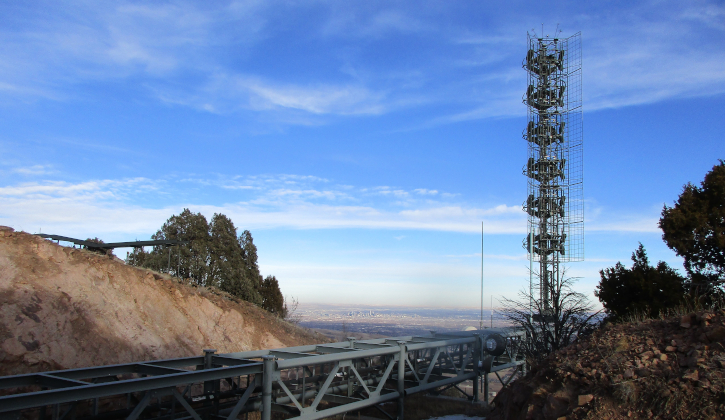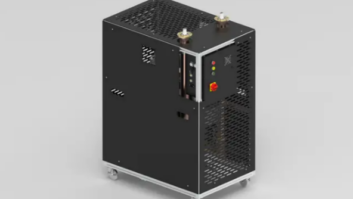
The author is a Denver-based engineer and lover of a good thunderstorm.
The Rocky Mountains are young as mountain ranges go. Colorado has 53 “fourteeners” … mountains over 14,000 feet above sea level. The mountains of the Front Range in the Denver radio market are only 7, 000 feet above sea level, but they are made from solid sandstone, limestone and granite rock.
These mountains are great for transmission sites — high altitude radio and television stations cover the market well. The area sees some extreme spring and summer thunderstorms as cold northern storm fronts meets warm, humid, southern air. Lightning strikes, both direct and remote, interact with the above-ground utility power lines that feed the sites. These natural events create issues ranging from minor AC line voltage transients to serious equipment damage.
Lightning
Lightning occurs when naturally occurring electrostatic charge builds up to a flashover voltage, ionizing the surrounding air. A great surge of electrical energy is released almost instantly to a point of low-voltage potential. Earth ground has a low-voltage potential because the free charged particles, also known as ions, are plentiful in the soil.
In the Rocky Mountains and other mountainous areas, the ground situation is different. Some mountains are solid or fractured rock which have little or no deep soil on the surface to “ground” the lightning strike. Radio, television and communications sites situated on rock summits need a sufficient RF ground. Remote lightning strikes several miles away can also, through inductance, enter power lines. A small power bump or a bit of electrical noise can lockup digital equipment.
Ground Systems
Where soil is plentiful, several copper rods driven into topsoil can provide an adequate electrical safety ground that meets NEMA electrical code. But what if there is little or no soil on the surface, such as on a rocky mountaintop? The median resistivity of topsoil is approximately 26 ohm-meters compared to the median resistance of solid rock that range from 1,000 to 5,000 ohm-meters. Low-resistivity soils typically contain more salt and moisture than high-resistivity soils.
[Subscribe to Radio World Engineering Extra.]
Symptoms of an inadequate RF ground system include transmitter and transmission line damage, equipment lockups and frequent circuit breaker trips. Communication sites built on solid or fractured rock may need a more substantial ground system; this can be done by adding chemical augmentation. Augmentation systems generally are made from copper tubing drilled with leach holes, and are filled with water and a salt such as magnesium sulphate. The brine solution leaks into the surrounding rock and improves ground conductivity with a greater supply of free ions.
Taming Lightning
When lightning strikes a tower, the energy enters the transmitter building, and then tears through the transmitter because the path of least impedance is located through the utility power ground in the transmitter. A properly designed and constructed RF ground system can reduce the probability of lightning damage. Electrical power systems typically use copper cable for grounding, but RF sites often use flat, copper strap which has a lower impedance at radio frequencies.
 Both electrical power and radio transmission lines should enter the building at the same point (bulkhead) with transmission lines being bonded to the RF ground node with short, low-impedance conductors. This is also a good location to place the RF ground buss bar and cable ground kits. Electrical power panels should be located near the RF ground node with both ground and neutral busses bonded to the RF ground node. All RF grounding connections should go “one way” with no reconnection to the RF ground node and no ground loop.
Both electrical power and radio transmission lines should enter the building at the same point (bulkhead) with transmission lines being bonded to the RF ground node with short, low-impedance conductors. This is also a good location to place the RF ground buss bar and cable ground kits. Electrical power panels should be located near the RF ground node with both ground and neutral busses bonded to the RF ground node. All RF grounding connections should go “one way” with no reconnection to the RF ground node and no ground loop.
Nautel has published a white paper entitled “Lightning Protection for Radio Transmitter Stations” that goes into more detail on this type of ground system.
One way to reduce lightning propagation to the transmitter is with ferrite cores slipped over the transmission line prior to connection to equipment. Although RF cables are grounded, there is still a low impedance in the outer conductor. Energy from a lightning strike to the antenna or transmission line may substantially bleed off before the line enters the building; yet enough energy may still travel on the outer conductor to cause damage. The ferrite core acts as a “choke,” by creating an impedance to the magnetic field created by the electrical current. It stores energy in a magnetic field, and eventually dissipates the energy as heat. Ferrite chokes can also be used on AC power mains.
Maintenance of RF ground systems includes recharging the chemical systems with water and salts. Ferrites should be periodically inspected to makes sure they are intact.
Electrical outlets should be the isolated ground type whereby the ground and neutral conductors stay isolated from the conduit. All conduit connections should be insulated where the metal meets the equipment cabinet. It’s best to home run all ground and neutral wires back to the power panel, daisy-chaining of these conductors can create ground loops.
Safety
Site safety becomes an issue when there is a poor site ground. Towers, buildings and steel appurtenances need to be connected to a good RF ground system, typically through exothermic welded cables. Air terminals (lightning rods) should be used liberally on the towers and buildings to dissipate atmospheric static charge and create a zone of safety from a strike. Parking lots and walkways should be built over a buried metal grid bonded to the facility ground buss. Metal fences, gates and door jambs should also be grounded.
Lightning strikes can also start wildfires that can threaten transmission sites. Some sites have alternate utility power paths in the event that the primary path is destroyed.
Mountain top sites offer many challenges, but good planning, good design and good construction provide the solution. One more thing … when in doubt, ground it.

RW welcomes your Tech Tips, email us at [email protected].












